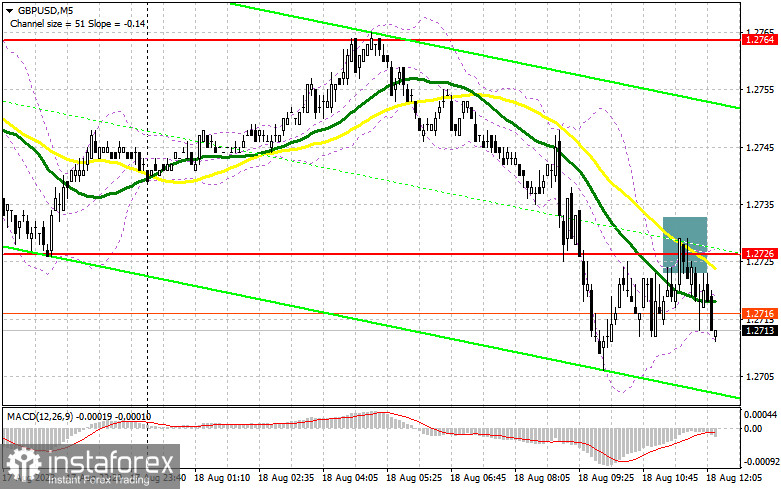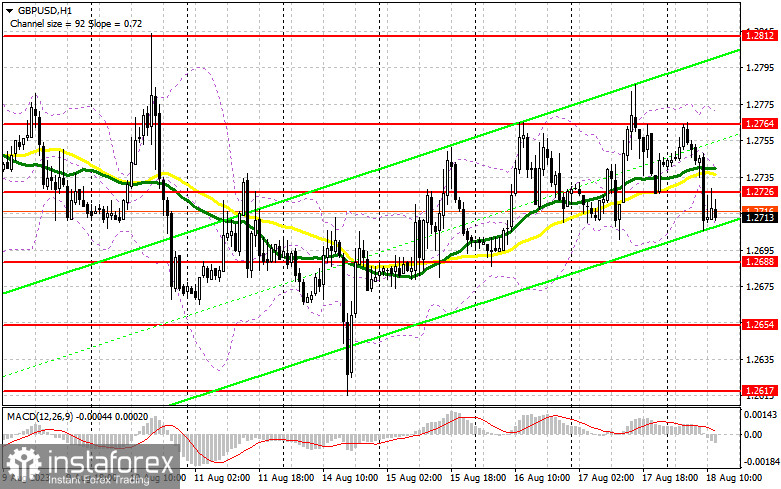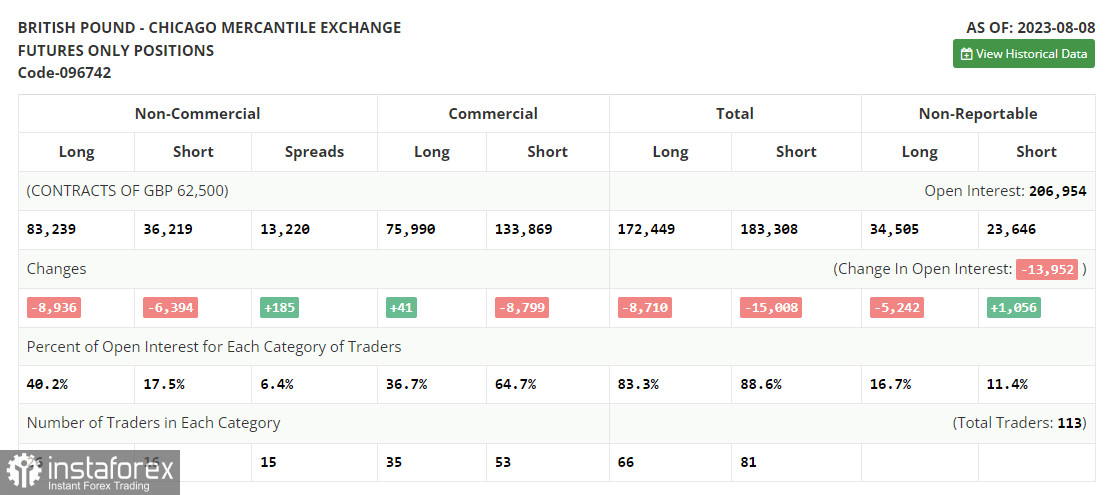In my morning forecast, I highlighted the 1.2726 level and recommended making market entry decisions from it. Let's look at the 5-minute chart and see what happened. The breakthrough and retest of this range following the relatively weak retail sales data in the UK led to a good sell signal for the pound. At the time of writing, the pair had already fallen more than 20 points.

To open long positions on GBP/USD:
The weak retail sales figures could have been better received, as they negatively affected the pace of economic growth. On the other hand, the decline in sales also allows the Bank of England to achieve its inflation targets, but this is also bad for the pound. Given the lack of US statistics in the second half of the day, I plan to act only after a decline and formation of a false breakout in the vicinity of the nearest support at 1.2688. This will provide an excellent entry point with a target of rising to resistance at 1.2726, which served as support earlier in the day. A breakthrough and test from above to below this range will form an additional buying signal, restoring the pound's strength and allowing it to reach a high of 1.2764. In case of an exit above this range, we can discuss a surge to 1.2812, where I will be locking in profits. In the scenario of GBP/USD falling and a lack of buyers at 1.2688 in the second half of the day, especially in the case of strong US labor market data, the pressure on the pair will only intensify, leading to a larger sell-off. If that happens, I will delay long positions to 1.2654. I will only buy there on a false breakout. Opening long positions on GBP/USD on a rebound can be done from 1.2617 with a correction target of 30-35 points within the day.
To open short positions on GBP/USD:
Bears managed to cope with the tasks set, and as long as trading is below 1.2726, I bet on the further decline of GBP/USD. In case the pair rises in the second half of the day, only the next formation of a false breakout in the area of 1.2726, analogous to what I analyzed above, will form a sell signal with the expectation of a decrease to the nearest support at 1.2688, formed as a result of yesterday's trading. A breakthrough and retest from below to above this range will give an entry point for selling to renew 1.2654. The further target will be the 1.2617 area, where I will be locking in profits. In the event of GBP/USD growth and the absence of bears at 1.2726 in the second half of the day, the bulls will regain control of the market, leading to the pair trading in a sideways channel. In such a case, only a false breakout in the area of the next resistance at 1.2764 will form an entry point for short positions. If there is no activity there as well, I advise selling GBP/USD from 1.2812, expecting a rebound of the pair down by 30-35 pips within the day.


Indicator signals:
Moving Averages
Trading occurs around the 30 and 50-day moving averages, indicating a sideways market trend.
Note: The author considers the period and prices of the moving averages on an hourly chart H1 and differ from the general definition of classical daily moving averages on the daily chart D1.
Bollinger Bands
In the event of a decline, the lower boundary of the indicator at 1.2706 will act as support.
Description of indicators:
• Moving average (determines the current trend by smoothing volatility and noise). Period 50. Marked in yellow on the chart.
• Moving average (determines the current trend by smoothing volatility and noise). Period 30. Marked in green on the chart.
• MACD indicator (Moving Average Convergence/Divergence - convergence/divergence of moving averages) Fast EMA period 12. Slow EMA period 26. SMA period 9.
• Bollinger Bands. Period 20.
• Non-commercial traders - speculators such as individual traders, hedge funds, and large institutions that use the futures market for speculative purposes and meet certain requirements.
• Long non-commercial positions represent the total long open position of non-commercial traders.
• Short non-commercial positions represent the total short open position of non-commercial traders.
• The total non-commercial net position is the difference between the short and long positions of non-commercial traders.
 English
English 
 Русский
Русский Bahasa Indonesia
Bahasa Indonesia Bahasa Malay
Bahasa Malay ไทย
ไทย Español
Español Deutsch
Deutsch Български
Български Français
Français Tiếng Việt
Tiếng Việt 中文
中文 বাংলা
বাংলা हिन्दी
हिन्दी Čeština
Čeština Українська
Українська Română
Română

